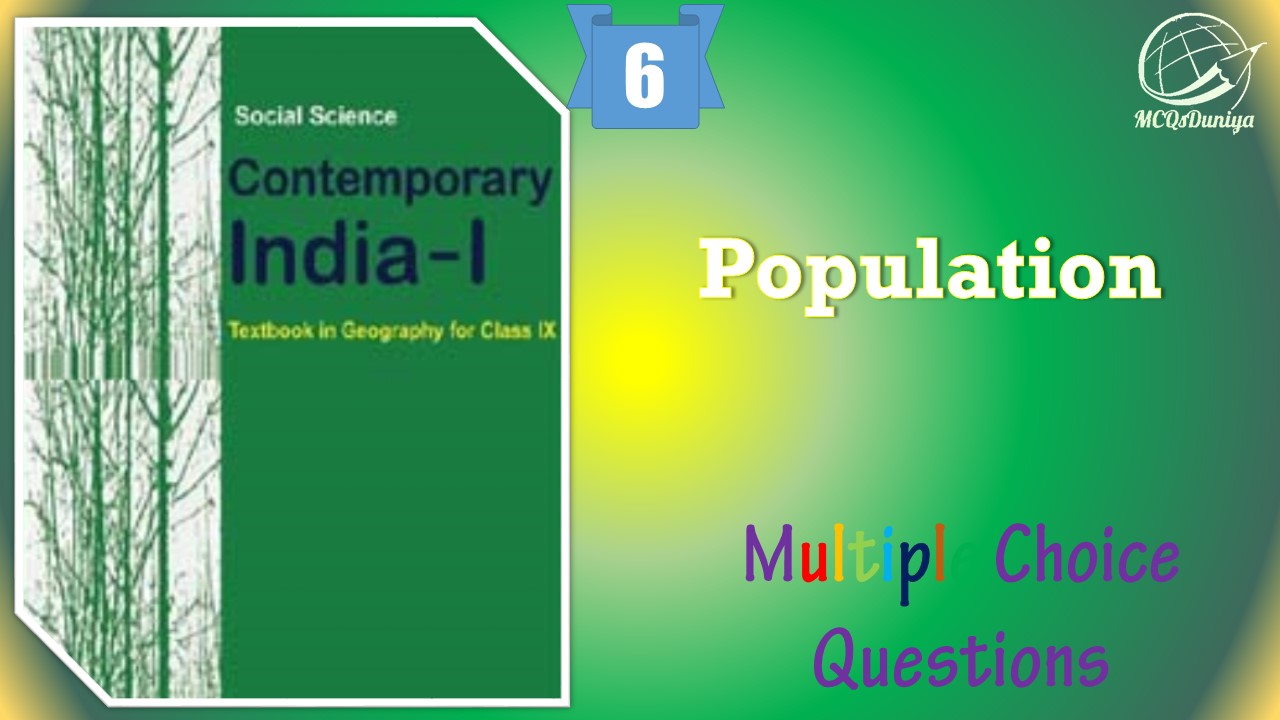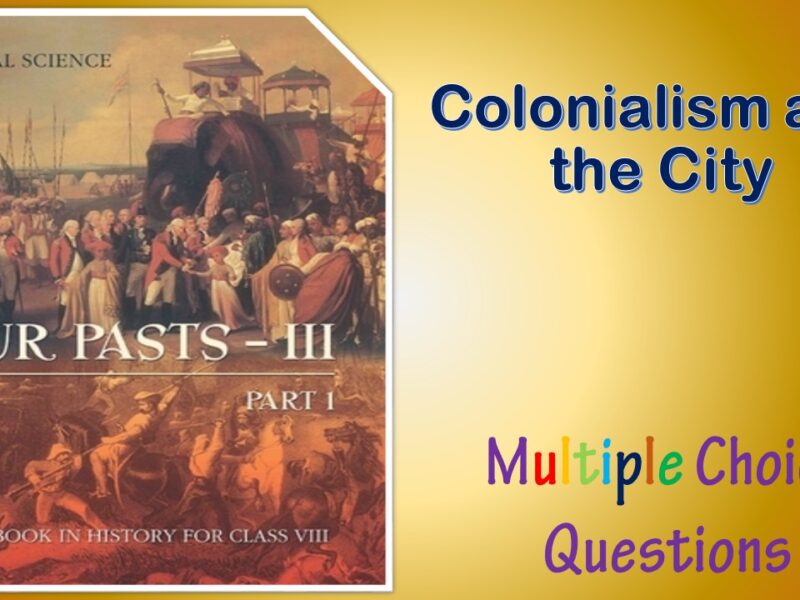Class 9 Social Science Geography MCQ Population with Answers is Prepared Based on Latest Exam Pattern. Students can solve NCERT Class 9 Social Science Geography MCQ Population with Answers to know their preparation level.
Students who are searching for NCERT Class 9 Social Science Geography MCQ Population with Answers are compiled here to get good practice on all fundamentals. Know your preparation level on MCQ Questions for Class 9 Social Science Geography MCQ Population with Answers. You can also verify your answers from the provided Class 9 Social Science Geography MCQ Population with Answers. So, ace up your preparation with MCQ of Class 9 Social Science Geography MCQ & NCERT Textbook solutions Examinations.
NCERT Class 9 Social Science Geography MCQ Population with Answers
Question : How much portion of population is engaged in secondary activities?
(a) 12%
(b) 10%
(c) 18%
(d) 16%
Answer :(a) 12%Show Answer :
Question : A large proportion of children in a population is a result of
(a) high birth rates
(b) high life expectances
(c) high death rates
(d) more married couples
Answer :(a) high birth ratesShow Answer :
Question : Which of the following age group is that of the working-age group?
(a) 15-30 years
(b) 15-40 years
(c) 15-60 years
(d) 15-59 years
Answer :(c) 15-60 yearsShow Answer :
Question : What is the literacy rate in Gujarat according to Censes 2001?
(a) 68.24%
(b) 69.97%
(c) 63.25%
(d) 65.93%
Answer :(b) 69.97%Show Answer :
Question : Which one of the following country has higher population density than India?
(a) Bangladesh
(b) Nepal
(c) Korea
(d) Canada
Answer :(a) BangladeshShow Answer :
Question : Which state has the lowest population in India?
(a) Uttar Pradesh
(b) Himachal Pradesh
(c) Sikkim
(d) All of these
Answer :(c) SikkimShow Answer :
Question : The pivotal element of demography is
(a) Literacy
(b) Population
(c) Healthcare
(d) None of the above
Answer :(b) PopulationShow Answer :
Question : Name the union territory which has highest population density:
(a) Delhi
(b) Chandigarh
(c) Punjab
(d) Port Blair
Answer :(a) DelhiShow Answer :
Question : Which is the point of reference from which all other elements are observed?
(a) Fauna
(b) Population
(c) Flora
(d) All of these
Answer :(b) PopulationShow Answer :
Question : An example of pull factor is
(a) Hunger
(b) Education
(c) Health
(d) Employment
Answer :(d) EmploymentShow Answer :
Question : What was India’s population in 1951?
(a) 361 million
(b) 265 million
(c) 295 million
(d) 461 million
Answer :(a) 361 millionShow Answer :
Question : What do you mean by the magnitude of population growth?
(a) The total population of an area
(b) The number of females per thousand males
(c) The number of persons added each year
(d) None of these
Answer :(c) The number of persons added each yearShow Answer :
Question : What year is considered a great demographic divide in India?
(a) 1911
(b) 1921
(c) 1931
(d) 1751
Answer :(b) 1921Show Answer :
Question : A large proportion of children in a poulation is result of:
(a) High birth rate
(b) High life expectancy
(c) High death rate
(d) More married couple
Answer :(a) High birth rateShow Answer :
Question : Which one of the following state has very high population density in India?
(a) West Bengal
(b) Madhya Pradesh
(c) Rajasthan
(d) All of these
Answer :(a) West BengalShow Answer :
Question : The most important attribute of population composition is
(a) Sex composition
(b) Age structure
(c) Education
(d) Health
Answer :(a) Sex compositionShow Answer :
Question : The magnitude of population refers to:
(a) The total population of an area
(b) The number of person added each year
(c) The rate at which the population increases
(d) The number of females per thousand males
Answer :(b) The number of person added each yearShow Answer :
Question : In how many years is the official enumeration of population carried out for census?
(a) 5 years
(b) 16 years
(c) 2 years
(d) 10 years
Answer :(d) 10 yearsShow Answer :
Question : The pace of population increase is measured as
(a) Percentage
(b) Range
(c) Mean
(d) None of the above
Answer :(a) PercentageShow Answer :
Question : Which one of the following state in India has a population density below 250 persons per square km?
(a) Punjab
(b) Haryana
(c) Chhattisgarh
(d) None of these
Answer :(c) ChhattisgarhShow Answer :
Question : NPP stands for
(a) National Population Policy
(b) National Provident Policy
(c) National Poverty Protection
(d) All of the above
Answer :(a) National Population PolicyShow Answer :
Question :Which India state has lowest density of population:
(a) Punjab
(b) Chennai
(c) West Bengal
(d) Arunachal Pradesh
Answer : (d) Arunachal PradeshShow Answer :
Due to difficult terrian/relief feature i.e., uneven land suface.
Question :……………. has the highest literacy rate:
(a) Kerala
(b) Tamil Nadu
(c) Bangalore
(d) Uttar Pradesh
Answer : (a) KeralaShow Answer :
According of census 2001.
Question :How much portion of population is engaged in secondary activities?
(a) 12%
(b) 10%
(c) 18%
(d) 16%
Answer : (a) 12%Show Answer :
a is correct.
Question : Which one of the following countries has higher population density than India?
(a) China
(b) Bangladesh
(c) Canada
(d) Korea
Answer : BShow Answer :
Question : Which of the following states of India has a moderate population density?
(a) Jammu and Kashmir
(b) Rajasthan
(c) Chhattisgarh
(d) Tamil Nadu
Answer : DShow Answer :
Question : Which of the following states has a population density below 250 persons per square km?
(a) Punjab
(b) Haryana
(c) Chhattisgarh
(d) Jharkhand
Answer : CShow Answer :
Question : The magnitude of population growth refers to which of the following?
(a) The number of persons added each year or decade
(b) The rate or the pace of population increase
(c) The total population of an area
(d) The number of females per thousand males
Answer : AShow Answer :
Question : Which among the following is included in the policy framework of NPP 2000?
(a) Imparting free and compulsory school education above 14 years age
(b) Reducing infant mortality rate
(c) Achieving universal immunization of children against all vaccine preventable diseases
(d) all of these
Answer : DShow Answer :
Question : Which one of the following is the most significant feature of the Indian population?
(a) Declining birth rate
(b) Improvement in the literacy level
(c) The size of its adolescent population
(d) Improvement in health conditions
Answer : AShow Answer :
Question : Which is the most populous country of the world?
(a) India
(b) United States
(c) China
(d) Russia
Answer : CShow Answer :
Question : Which of the following factors are responsible for sparse population?
(a) Flat plains and abundant rainfall
(b) Rugged terrain and unfavourable climate
(c) Fertile soil and abundant rain fall
(d) Rugged terrain and favourable climate
Answer : BShow Answer :
Question : Birth rate is the number of live births per thousand persons in :
(a) 10 years
(b) 5 years
(c) 2 years
(d) 1 year
Answer : DShow Answer :
Question : Migrations change the number, distribution and composition of the population in
(a) the area of departure
(b) the area of arrival
(c) both the area of departure and arrival
(d) none of the above
Answer : CShow Answer :
Question : Which one of the following country has higher population density than India?
(a) Bangladesh
(b) Nepal
(c) Korea
(d) Canada
Answer : AShow Answer :
Question : Which is the point of reference from which all other elements are observed?
(a) Fauna
(b) Population
(c) Flora
(d) All of these
Answer : BShow Answer :
Question :What is the literacy rate in Gujarat according to Censes 2001?
(a) 68.24%
(b) 69.97%
(c) 63.25%
(d) 65.93%
Answer : (b) 69.97%Show Answer :
According to census data available to us (2001)
Question :The greatest literacy rate, among the four given states is of:
(a) Jharkhand
(b) Orissa
(c) Chattisgarh
(d) Uttar Pradesh
Answer : (c) ChattisgarhShow Answer :
c is correct.
Question :Country’s human resources are called?
(a) Density
(b) Man-power
(c) Census
(d) Age composition
Answer : (b) Man-powerShow Answer :
Is the definition of Human Resources of a country.
Question :India is the ……………. most populated country in the world.
(a) Fifth
(b) First
(c) Second
(d) Third
Answer : (c) SecondShow Answer :
Because China is most populous country in the world.
Question :……………. is the state where the density of the population is 100 to 200 persons per sq. km.
(a) Madhya Pradesh
(b) Rajasthan
(c) West Bengal
(d) Uttar Pradesh
Answer : (a) Madhya PradeshShow Answer :
According to census.w
Question :Name the union territory which has highest population density:
(a) Delhi
(b) Chandigarh
(c) Punjab
(d) Port Blair
Answer : (a) DelhiShow Answer :
It is due to national capital and more carrier facilites available here
Question :Which Indian state has highest density of population:
(a) Rajasthan
(b) Madhya Pradesh
(c) West Bengal
(d) Haryana
Answer : (c) West BengalShow Answer :
According to census of India conducted in 2001.
Question :What was India’s population in 1951?
(a) 361 million
(b) 265 million
(c) 295 million
(d) 461 million
Answer : (a) 361 millionShow Answer :
According to census conducted in this year.
Question :What is the literacy rate in India?
(a) 94%
(b) 40%
(c) Nearly 100%
(d) 64-84%
Answer : (d) 64-84%Show Answer :
d is correct.
Question :A large proportion of children in a poulation is result of:
(a) High birth rate
(b) High life expectancy
(c) High death rate
(d) More married couple
Answer : (a) High birth rateShow Answer :
Because high birth rate adds to number of people in population.
Question :According to census 2001, a literate person is one who:
(a) Can read and write his/her name
(b) Can write his/her name
(c) is 7 years old and can read, and write any language with understanding
(d) Knows the 3 ‘Rs’.
Answer : (c) is 7 years old and can read, and write any language with understandingShow Answer :
According to Serve Siksha Abhiyan programme immplements by government.
Question :The magnitude of population refers to:
(a) The total population of an area
(b) The number of person added each year
(c) The rate at which the population increases
(d) The number of females per thousand males
Answer : (b) The number of person added each yearShow Answer :
Others are definition of population density, population growth rate and sex ratio.
Question :Which of the followings is not the component of population growth:
(a) Birth Rate
(b) Death rate
(c) Migration
(d) Sex Ratio
Answer : (d) Sex RatioShow Answer :
Because it refers to the number of female per thousand, other are the growth rate of population.
Question : What year is considered a great demographic divide in India?
(a) 1911
(b) 1921
(c) 1931
(d) 1751
Answer : BShow Answer :
Question : Which India state has lowest density of population:
(a) Punjab
(b) Chennai
(c) West Bengal
(d) Arunachal Pradesh
Answer : DShow Answer :
Question :Migrations change the number, distribution and composition of the population in
(a) the area of departure
(b) the area of arrival
(c) both the area of departure and arrival
(d) none of the above
Answer : CShow Answer :
Question : Which of the following age group is that of the working-age group?
(a) 15-30 years
(b) 15-40 years
(c) 15-60 years
(d) 15-59 years
Answer : CShow Answer :
Question :What percentage of India’s population resides in the most populated state of India, Uttar Pradesh?
(a) 38.96 per cent
(b) 14.37 per cent
(c) 16.16 per cent
(d) 20.56 per cent
Answer : CShow Answer :
Question :What is the literacy rate in Gujarat according to Censes 2001?
(a) 68.24%
(b) 69.97%
(c) 63.25%
(d) 65.93%
Answer : BShow Answer :
Question :In how many years is the official enumeration of population carried out for census?
(a) 5 years
(b) 16 years
(c) 2 years
(d) 10 years
Answer : DShow Answer :
Question : Which one of the following states has very high population density?
(a) West Bengal
(b) Madhya Pradesh
(c) Rajasthan
(d) Arunachal Pradesh
Answer : AShow Answer :
Question :……………. is the state where the density of the population is 100 to 200 persons per sq. km.
(a) Madhya Pradesh
(b) Rajasthan
(c) West Bengal
(d) Uttar Pradesh
Answer : AShow Answer :
Question : Which of the following southern states has a high population density?
(a) Karnataka
(b) Andhra Pradesh
(c) Kerala
(d) Tamil Nadu
Answer : CShow Answer :
Question : What do you mean by the magnitude of population growth?
(a) The total population of an area
(b) The number of females per thousand males
(c) The number of persons added each year
(d) None of these
Answer : CShow Answer :
Question : The number of people in different age groups is referred as :
(a) Sex ratio
(b) Age composition
(c) Adolescent population
(d) Occupational structure
Answer : BShow Answer :
Question : A large proportion of children in a poulation is result of:
(a) High birth rate
(b) High life expectancy
(c) High death rate
(d) More married couple
Answer : AShow Answer :
Question : What is sex ratio?
(a) Number of females per thousand males
(b) Number of females per hundred males
(c) The study of population growth
(d) Difference between birth rate and death rate
Answer : AShow Answer :
Question : Who among the following is resource creating factors as well as resources themselves?
(a) Animals
(b) Plants
(c) Human beings
(d) Nature
Answer : CShow Answer :
Question : India accounts for what percentage of the world population?
(a) 1.02 per cent
(b) 2.4 per cent
(c) 3.28 per cent
(d) 16.7 per cent
Answer : DShow Answer :
Question : Almost half of India’s population lives in just five states. Which one of the following is not one of these five populous states?
(a) Maharashtra
(b) Bihar
(c) West Bengal
(d) Arunachal Pradesh
Answer : DShow Answer :




